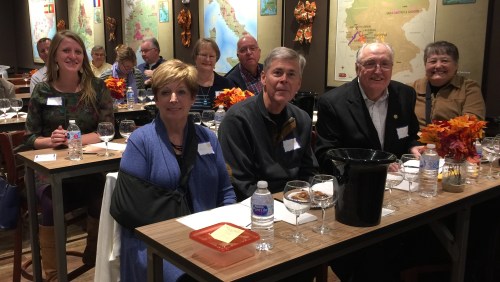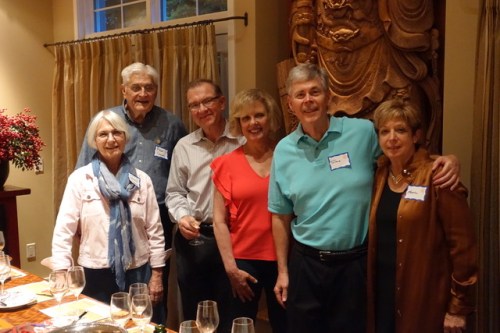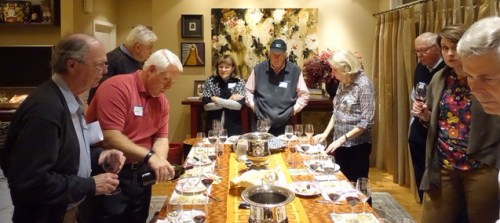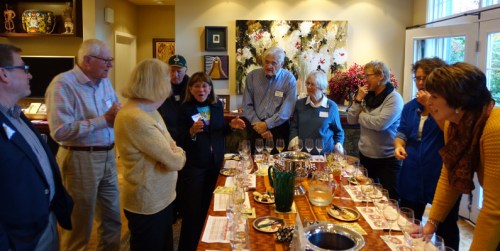submitted by Mike Wilson; photos by Pete Christianson

Last night, October 16, we had a wine tasting at Total Wine & More at West Towne Shopping Center. Fellow Rotarian Megan Ballard had been instrumental in arranging this tasting, and with Mike Wilson had met with the manager when we selected an upgraded Bordeaux tasting where the Right and Left Banks were contrasted. Justin Duffy is in charge of the actual tasting content, and usually Total Wine has 7 wines with a store cost up to $30 and a tasting fee of $20. Our tasting included 10 wines, and the price range was $15.99 to $44.99 because we purchased an upgraded tasting. Only one wine was provided without a score, and the remainder were ranked by good sites as 90 – 95 points (an incredible 93.1 mean score). This was an excellent tasting.
Bordeaux is the worlds most successful Wine region, although going through a little spot of bother now with competing new world “Bordeaux varietals”. They developed a system that over centuries benefited the producers – to the point they sell their wines on “pre-order” before they are even bottled or officially rated by critics. For the last two centuries they reigned supreme as the most prestigious wine region in the world.
The region’s most important grapes are Sauvignon Blanc and Semillon (white) and Cabernet Sauvignon and Merlot (red). The other red grapes are either to soften tannins, or to add tannin and/or color to the blends.
The Left Bank is to the southwest (left on the map) of the Gironde estuary and the Garonne river. This includes the Bas-Medoc and the Haut-Medoc (this latter High Medoc contains the 4 AOC’s that are the home of the greatest collection of top-quality wines anywhere in the world – St-Estephe, Pauillac, St-Julien and Margaux). Further inland is the city of Bordeaux then follows Graves, an appellation famous for BOTH red and white wines, and most inland is Barsac and Sauternes (the sweeties of Bordeaux) made as a result of “Noble Rot”, the result of infection by the mold botrytis. This is not made every year as it is dependent on the infection of the grapes, but the “first great growth” of this region is Chateau Y’Quem – with it’s own designation in the 1855 Classification of Bordeaux.
The Right bank is east and north of the Gironde Estuary and the Dordogne River (Right on the map and exclusively making Red wines – the two R’s). This region is better suited to Merlot grapes, with Cabernet Franc also doing well. Many appellations exist, with the best being Fronsac, Pomerol and St. Emilion with their subregions. While Pomerol has never been classified (like the 1855 classification of Bordeaux) St. Emilion successfully petitioned and resulted in a grand cru classe (2 only vs 5 for Bordeaux ) and premier grand cru classe.
Between the two rivers are the Entre-deux-mers (between the seas – the river/tidal flow) made of exclusively dry white wines made predominantly from Sauvignon Blanc. The other white grapes are semillon and muscadelle. The red wine made here is usually Merlot, and are classified as regional Bordeaux or Bordeaux Superieur wines rather than Entre deux mers wine.
We had great examples of all these wines. We started with a $15.99 Entre Deux Mers that was glorious but unranked. We next had a Sauvignon Blanc a Ch. Doisy-Daene 2016 94 pointer that sells for $34.99.
We then were switched over to the Right Bank (Libournais wines after the largest city) and had a Fronsac Ch. Dalem 2015 ($29.99 94 pts), a Pomerol Chateau Garraud ($29.99 93 pts – which I liked the most) and CH. Quinault L’Encolos – St. Emilion ($45 94 pts). All were excellent.
Now we moved to the Left Bank. We started with a 2015 Ch Labegorce Margaux which was fabulous and rated 95 pts at only $39.99. I rated this the same and was my favorite. Next was a 2014 St. Julien Ch Lagrange ($44.99 94 pts) which comes from the commune with highest proportion of classified growths. The chateaux is a 600 year old building. Next was a 2014 St Estephe Ch. Lilian Ladouys ($39.99 93 pts). To complete the Left Bank AOC’s we had a 2014 Pauillac Ch. Lynch Bages second label ECHO ($44.99 92 pts).
The last wine was a Sauternes (furtherest inland of the Left Bank) a 2013 Ch Cantegril ($29.99 90 pts). I thought this was superb and rated as a 95, likely as I love these sweet wines in all formats, even as “ice martinis” – the topic of a future tasting “Wines and wine cocktails”.
So we were shown all the regions, all the Haut Medoc AOCs, with excellent wines and great prices. In the pricing structure if you see a wine that ends in 99 cents then that means if you buy 6 of any of these you get a 10% discount on all, as it represents one of the wines they have special relationships with the Distributer. All of these wines were in that category. A good time was had by all.






























 When thinking of these Cal-Ital wines one can concentrate the early wineries founded by first and second generation Italian-American families and the examples are many: Gallo, Robert Mondavi, Louis Martini, Sebastiani, Simi, Seghesio, Foppiano, Trinchero, Rochioli, Martinelli and Rafanelli and who among us have not tasted some great wine from these folks. This was addressed by Michael Pare at the start, and Dave Ginocchio added to this idea with three appropriate old “Italifornia” photographs at the top of the price list/ordering sheet provided.
When thinking of these Cal-Ital wines one can concentrate the early wineries founded by first and second generation Italian-American families and the examples are many: Gallo, Robert Mondavi, Louis Martini, Sebastiani, Simi, Seghesio, Foppiano, Trinchero, Rochioli, Martinelli and Rafanelli and who among us have not tasted some great wine from these folks. This was addressed by Michael Pare at the start, and Dave Ginocchio added to this idea with three appropriate old “Italifornia” photographs at the top of the price list/ordering sheet provided.







